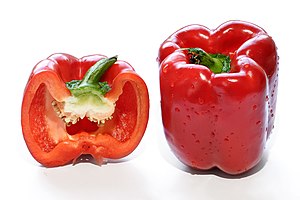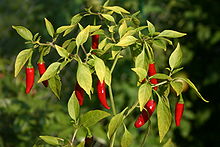Capsicum
| Capsicum | |
|---|---|
 | |
| Genus: | Capsicum |
| Family: | Solanaceae |
| Pollination: | Insects |
Capsicum is a genus of plants from the nightshade family (Solanaceae). Some of the members of Capsicum are used as spices, vegetables, and medicines. The fruit of Capsicum plants have a variety of names depending on place and type. They are commonly called chilli pepper, red or green pepper, or just pepper in Britain and the US; the large mild form is called bell pepper in the US, capsicum in Australian English and Indian English, and paprika in some other countries (although paprika can also refer to the powdered spice made from various capsicum fruit).
Capsicums originated in the Americas, but are now grown worldwide. The name given to the fruits varies between English-speaking countries.
In Australia, New Zealand and India, heatless species are called "capsicums" while hot ones are called "chilli/chillies". The term "bell peppers" is rarely used, usually in reference to C. annuum and other varieties which look like a "capsicum" or bell but are fairly hot.
In the United Kingdom, Ireland, and Canada, the heatless varieties are called "peppers", "sweet peppers" or "capsicums" (or "green peppers," "red peppers," etc.) while the hot ones are "chilli/chillies" or "chilli peppers".
In the United States, the common heatless species is referred to as "bell peppers," "sweet peppers," "red/green/etc peppers," or simply "peppers", while the hot species are collectively called "chile/chiles," "chili/chilies," or "chili/chile peppers" (one L only), "hot peppers", or named as a specific variety (e.g., banana pepper). In many midwestern regions of the United States the Sweet Bell Pepper is commonly called a mango [1] With the modern advent of fresh tropical fruit importers exposing a wider latitude of individuals to the tropical fruit variety of the Mango, this definition is becoming archaic. However many menus still call a stuffed Bell Pepper a Mango.
The name "pepper" came into use because the plants were hot in the same sense as the condiment black pepper, Piper nigrum. But there is no botanical relationship with this plant, nor with Sichuan Pepper.

In Indian English, the word "capsicum" is used exclusively for bell pepper. All other varieties of chili peppers are called chilli.
Description
[edit | edit source]Peppers are shrubby perennials, typically with simple, entire leaves. Flowers are white, in axillary groups.
Growing Conditions
[edit | edit source]Full sun, rich, well-drained soil, with adequate irrigation.
Species
[edit | edit source]- Capsicum annuum
- (incl. bell pepper, paprika, pimento, jalapeño, cascabel)
- Capsicum frutescens
- (incl. cayenne pepper, African birdseye)
- Capsicum chinense
- (incl. habanero, scotch bonnet, Naga Jolokia pepper)
- C. pendulum (incl. Piri piri)
- C. pubescens (incl. rocoto)
- C. minimum
- C. baccatum (incl. Ají)
- C. abbreviatum
- C. anomalum
- = Turbocapsicum anomalum
- C. breviflorum
- C. buforum
- C. brasilianum
- C. campylopodium
- C. cardenasii
- C. chacoense
- C. ciliare
- C. ciliatum
- C. chlorocladium
- C. coccineum
- C. cordiforme
- C. annuum
- C. cornutum
- C. dimorphum
- C. dusenii
- C. exile
- C. eximium
- C. fasciculatum
- C. fastigiatum
- C. frutescens
- C. flexuosum
- C. galapagoensis
- C. geminifolum
- C. hookerianum
- C. lanceolatum
- C. leptopodum
- C. luteum
- C. microcarpum
- C. minutiflorum
- C. mirabile
- C. parvifolium
- C. praetermissum
- C. schottianum
- C. scolnikianum
- C. stramonifolium
- Witheringia stramonifolia
- C. tetragonum
- C. tovarii
- C. villosum
- C. violaceum
Uses
[edit | edit source]Capsicum fruits can be eaten raw or cooked. Those used in cooking are generally varieties of the C. annuum and C. frutescens species, though a few others are used as well. They are suitable for stuffing with fillings such as cheese, meat or rice.
They are also frequently used both chopped and raw in salads, or cooked in stir-fries or other mixed dishes. They can be sliced into strips and fried, roasted whole or in pieces, or chopped and incorporated into salsas or other sauces.
They can be preserved by drying or pickling. Dried peppers may be reconstituted whole, or processed into flakes or powders. Pickled or marinated peppers are frequently added to sandwiches or salads. Extracts can be made and incorporated into hot sauces.
The fruit of most species of Capsicum contains capsaicin (methyl vanillyl nonenamide), a lipophilic chemical that can produce a strong burning sensation in the mouth (and, if not properly digested, anus) of the unaccustomed eater. Most mammals find this unpleasant; however, birds are unaffecte.[2][3] Apparently, the secretion of capsaicin is an adaptation to protect the fruit from consumption by mammals while the bright colors attract birds that will spread the seeds. The amount of capsaicin in peppers is highly variable and dependent on genetics, giving almost all types of peppers varied amounts of perceived heat. The only pepper without capsaicin is the bell pepper. Chile peppers are of great importance in Native American medicine, and capsaicin is used in modern Western medicine—mainly in topical preparations—as a circulatory stimulant and pain reliever.
Most of the capsaicin in a pepper is found in the interior ribs that divide the chambers of the fruit, and to which the seeds are attached. At the stem end of the pod, glands secrete the capsaicin, which then spreads throughout, but is concentrated on the ribs and seeds. The amount varies very significantly by variety, and is measured in Scoville heat units (SHU), ranging from the mild bell pepper to the scorching Habanero chile.
In addition to the colunary varieties, some peppers are also grown as ornamental plants, for their colorful and showy fruits.
Maintenance
[edit | edit source]Propagation
[edit | edit source]Primarily by seed, though cuttings can be made if desired. Seedlings are usually started in flats, then transplanted to the field.
Harvest
[edit | edit source]Harvest fruits when green or when fully ripe.
Pests and Diseases
[edit | edit source]White Mold (Scletotinia sclerotiorum)
Southern Blight (Sclerotium rolfsii)
- Green Peach Aphid: Myzus persicae
- Potato Aphid: Macrosiphum euphorbiae
- Melon Aphid: Aphis gossypii
- Bean aphid: Aphis fabae
- Hemispherical scale: Saissetia coffeae
- Tomato Psyllid: Bactericerca cockerelli
- Tarnished Plant Bug: Lygus lineolaris
- Garden Fleahopper: Halticus bractatus
- Western Flower Thrips: Frankliniella occidentalis
- Onion Thrips: Thrips tabaci
- American Serpentine Leafminer: Liriomyza trifolii
- Pepper Maggot: Zonosemata electa
- Palestriped Flea Beetle: Systena blanda
- Potato Flea Beetle: Epitrix cucumeris
- Western Potato Flea Beetle: Epitrix subcrinita
- Pepper Weevil: Anthonomus eugenii
- Beet Armyworm: Spodoptera exigua
- Yellowstriped Armyworm: Spodoptera ornithogalli
- Western Yellowstriped Armyworm: Spodoptera praefica
- Variegated Cutworm: Peridroma saucia
- European Corn Borer: Ostrinia nubilalis
- Corn Earworm: Helicoverpa zea
- Tobacco Budworm: Heliothis virescens
- Hornworms
- Broad Mite: Polyphagotarsonemus latus
- Cyclamen Mite: Steneotarsonemus pallidus
See also
[edit | edit source]| The Cookbook contains recipes for Bell Pepper |
References
[edit | edit source]- Capsicum pepper factsheet as of 2002-06-10
- Chile varieties as of 2003-11-07
- Chile varieties database as of 2006-10-27
- Cranshaw, Whitney (2004). Garden Insects of North America: The Ultimate Guide to Backyard Bugs. Princeton University Press. p. 585.
- Pippa Greenwood, Andrew Halstead, A.R. Chase, Daniel Gilrein (2000). American Horticultural Society Pests & Diseases: The Complete Guide to Preventing, Identifying, and Treating Plant Problems (First Edition ed.). Dorling Kindersley (DK) Publishing, inc. p. 203.
{{cite book}}:|edition=has extra text (help)CS1 maint: multiple names: authors list (link)
- ↑ http://www.m-w.com/dictionary/mango
- ↑ Mason, J. R., Bean, N. J., Shah, P. S. & Clark, L. Journal of Chemical Ecology 17,2539–2551 (1991)
- ↑ Norman, D. M., Mason, J. R. & Clark, L. The Wilson Journal of Ornithology 104, 549–551 (1992).
